Does this sound familiar?
You come up with a genius idea for a blog topic that you know for a fact your readers are going to love.
You spend an entire Sunday banging out that blog content.
After you create your content masterpiece, you publish the blog and promote it like crazy on social media, email newsletters and other avenues.
All that work to find that two weeks later, the traffic has plateaued and is almost nonexistent… and has stayed that way for months now.
If that rings a bell, know that you’re not alone.
Many entrepreneurs and marketers fall into this trap because they spend all their time creating but not promoting their blog content. They either lack the focus, or the expertise to properly promote their blog.
But it doesn’t have to be this way. In our time, our team of content writers/ marketers have helped dozens of businesses, just like yours, create breakthrough after breakthrough in their blog growth. Now it’s your turn.
In this blog, we’ll outline for you what the true measurement of a successful blog looks like, how to fill up your editorial calendar with awesome blog content ideas, how to do proper blog keyword research, and show you some blogging tools to add to your treasure chest.
So first off, why is blogging important?
Blogging has become of the name of the game when it comes to reaching new audiences online. Not only does it help with SEO and bringing in new traffic to your website, it also helps position you or your company as a leader in your industry as you dole out thoughtful advice and information on a range of compelling topics. Marketers who prioritize blogging efforts are 13x more likely to see positive ROI. But with so many blogs online, finding an audience isn’t exactly guaranteed.
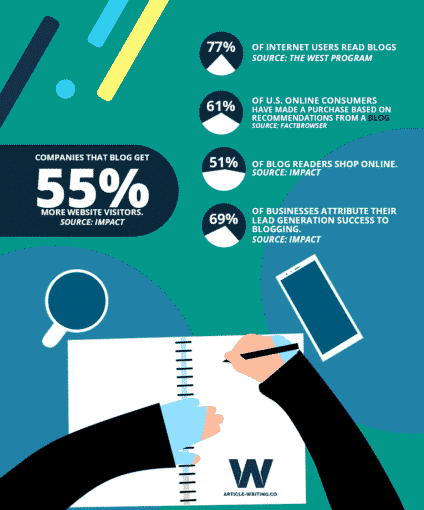
How Should I Measure My Blog? Traffic vs. Leads
Getting people to look at your blog is one thing, but business owners don’t just want eyeballs on their site. They want to increase their bottom line by having the viewer take the next step.
Thus, tracking website leads is usually a more effective way to measure the success of your blog.
This might sound obvious, but many marketers and entrepreneurs trick themselves by having web traffic as their KPI, which is a vanity metric. Use conversions as your primary KPI, and other metrics such as traffic or time on page
Before you can think about bringing in more blog traffic, you need to have a way to measure your existing traffic. Talk to your web host to see if there’s a way to measure your incoming traffic. Most web hosts like Squarespace or WordPress have built-in website analytics programs you can use to measure the number of people clicking on your website, what web pages they visit, and how long they stay logged on to your website. You can also use a third-party website analytics program to see what kinds of users are logging onto your website.
When you’re measuring the results, you can look at the number of overall traffic coming to your website or the total number of leads. A lead is any user that engages with your website by signing up for an email newsletter, subscribing to content, filling out a form with their personal information or putting a product in their online shopping cart.
What Does a Successful Blog Look Like? Compound Blog Traffic vs. Spike in Blog Traffic
Now that you have your eye on some key blog metrics, you might be wondering what a successful blog actually looks like.
When you’re tracking your web traffic day in and day out, you want to watch those number to go up and up. But most companies tend to see a spike in blog traffic thanks to social media, email newsletters, or a PPC campaign, but then that traffic goes away.
The ideal is to have a steady influx of traffic.
There are two ways to create this steady influx.
A successful blog should feature a mix of new and returning viewers.
The first way is through returning users. Even if you’re bringing in more readers by promoting your blog to death, those viewers need to stick around if your blog is going to be a success.
This means that the people that have already read your blog like the content and are willing to come back for a second helping, and you’re still bringing in new viewers and expanding your audience. Make sure you can distinguish between new and returning users when measuring your incoming traffic.
The second way is through SEO.
Post on social, send out an email newsletter, and you’ll see a spike the same day of the share. Appear on search rankings however, and you will capture searchers every month in a sustainable way.
Below in the keyword research section, we will elaborate on how to rank for the relevant keywords and earn consistent traffic.
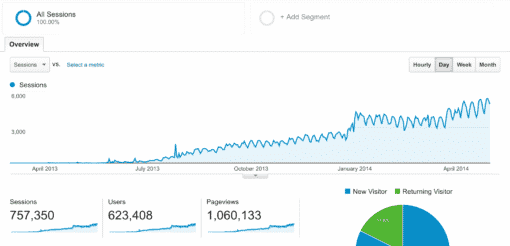
Customer Acquisition and Blogs: Word of Mouth, Search, Advertisement
When you’re writing a piece of content, you can give it legs by sending it out to a certain channel, whether it’s social media, a search engine like Google, a paid search listing, or word-of-mouth marketing. In order to increase your blog traffic, you need to figure out how to optimize your content for each channel. Some channels will work better for some than others. It all depends on where your users spend their time online.
Start sharing your blog posts on different channels and measure the success of each post. You can start modifying your approach based on how responsive your audience is to the post. Maybe you realize that posts on LinkedIn need to have a more formal tone, while your followers on Facebook like to see more humor and visual imagery.
Once you’ve explored the effectiveness and the reach of several different channels, you can start prioritizing these channels when promoting your content. Some of these channels will be better suited to your company and will help you find the long-term results that you’ve been looking for.
How to Find Content Ideas for Your Blog and How Often You Should Post
Many digital publishers will struggle when trying to come up with compelling ideas for their posts.
The best way to go about this is to find out what your target audience is interested in.
People will use certain keywords related to their industry to optimize their content for SEO, but they often miss the what the person is actually searching for when they plug these keywords into Google. If you’re trying to attract certain kinds of users, step into their shoes and try to generate content that will grab their attention and keep it.
You can also try browsing the web to learn more about what your target audience is interested in. Some suggestions include:
- Finding what kinds of articles or posts your followers enjoy on social media
- Browsing websites like Reddit, Quora and Twitter to see what’s trending
- Checking out what courses on Udemy are popular (if people are willing to pay to learn about the subject, you know it’s a big topic)
- Using a tool like Buzzsumo or Ahrefs to find additional content on a particular subject.
- Using your own website analytics to see what pages, products, or posts are most popular with your users
- Tracking important industry updates and authoritative news articles
Now, you’re probably wondering how often you should be posting. As you can see in the infographic below, the more indexed pages and blog posts a company has to its name, the more leads and traffic it will get online. But every industry is different. If you feel like you’re posting subpar content just so you can post more frequently, you might want to rethink your strategy. Whether you’re posting daily or weekly, try to be consistent with your posting schedule. Blog readers are 79% more likely to read in the morning, so it’s usually best to start posting early in the morning.
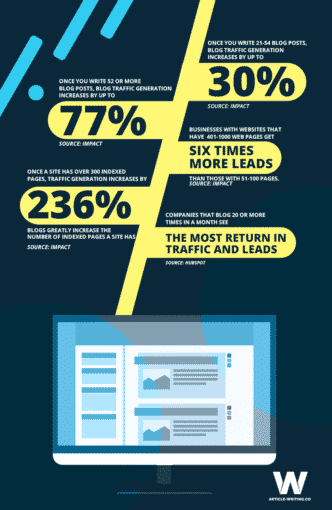
You can also use a content calendar to keep track of your posting schedule. You can put ideas and topics on the calendar to map out your blog activity months in advance, so you never miss a beat. Companies that blog 20 or more times in a month see the most return in traffic and leads, so start brainstorming!
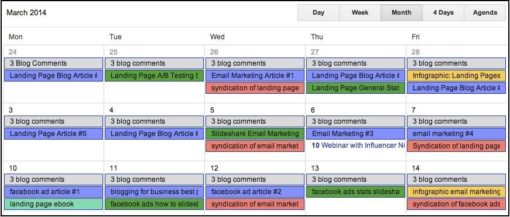
How to Choose the Best Keywords for Your Blog
Now, let’s examine how to choose the right keywords for your blog.
As mentioned above, one of the most effective ways to generate consistent traffic is through SEO or search engine optimization. This will help you bring in a lot of traffic to your blog by listing your website in the search results on Google.
To get started, you can use the Google AdWords Keyword Planner. This tool will show which search terms in your industry are the most popular. You should only use search terms that are directly related to your business, so you don’t end up attracting users that aren’t interested in what your business is trying to sell.
It’s also best to use a mix of short tail and long tail keywords. Short tail keywords are more general such as “Real Estate Agent Toronto”. A long tail keyword is longer in nature and more specific, such as “Top Real Estate Agent for selling homes in Toronto”.
Short tail keywords that get tens of thousands of hits every month are going to be rife with competition and it could take years for your business to crack the top ten search results on Google. But long tail keywords can be a great place to get your foot in the door. Try to incorporate both into your SEO strategy, so you can rank highly for some keywords and take your time with the more popular terms.
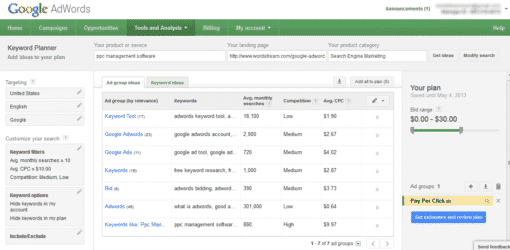
You can also use the Keyword Planner to better gauge how popular certain topics will be with users online. If a search term is extremely popular, you can base your ideas around the term and try to incorporate it into your copy.
Another popular tool to use for keyword research is Ahrefs.
Use a tool like Ahrefs to find opportunities to rank for keywords with high search volumes.
Ahrefs is an advanced SEO tool, which shows you what type of traffic the top 10 results for a certain keyword achieve. It reveals what other keywords the websites in the top 10 rank for. It has a few more functionalities but those are two of the primary ones.
There’s a multitude of functionalities on Ahrefs but here is one example of how I use Ahrefs to find those opportune keywords:
Step 1: Put yourself in your target audiences shoes and brainstorm a keyword they might type in
Step 2: Pull up the Keyword Explorer and type in that search
Step 3: Take a look at the results/ sites with the most search volume and click on kw (keywords)
Step 4: This will populate a list of keywords along with the volume that is generated for that specific site
Step 5: Take that keyword and input it again into the keyword explorer tool, this time you want to take a look at the keyword difficulty
Step 6: Rinse and repeat this process until you can find a keyword with decent search volume and a low keyword difficulty. You can usually find gems that are related to a site’s blog.
Anatomy of a Blog Page with Perfect On-Page SEO
When the time comes to write and upload a post to your website, you need to complete a series of steps to make sure that your post is perfectly optimized for SEO. Otherwise, no one will be able to find your post online. Make sure every post has the following:
- Title Tag: Put your keyword in the title. You can modify your keyword but try to stay as close as possible to original search term. You can also use certain words to attract more users online, such as “best”, “guide”, “tips” or a numbered list. Titles with 6-13 words attract the highest and most consistent amount of traffic.
- URL: Modify your blog post URL to include the keyword and keep it short and sweet.
- H1 Tag: Incorporate the same keyword into your H1 tag. Some website building templates will do this automatically.
- Visual Media: Keep the user engaged by adding high-resolution images, videos, or an infographic.
- First 100 Words: Use your keyword in the first 100 words of your blog post.
- Mobile-Friendly: Make sure your blog post and website are mobile-friendly. Google will penalize your website if it’s not optimized for mobile devices.
- Internal Links: Link to 2 to 3 authoritative websites throughout your blog post.
- Site Speed: Make sure your blog post page loads in 3 seconds or less.
- Use LSI Keywords: LSI keywords are words or phrases that are similar to your main keyword. Add a few to your blog post to help Google understand the topic at hand.
- ALT Tags: Label each image with ALT tags related to your keyword and save the image file as a keyword.
- Social Media: Add social media buttons at the top or bottom to encourage your users to share your content online.
- Content Length: The longer the better. Try to beef up your word count to at least 500 words, if not 1,500 words. The average blog post is 10,50 words.
How to Make Your Content Go Viral and Boost Blog Traffic
Obviously, if your content goes viral, you will boost your blog traffic.
But in order for a piece to go viral, it needs to be something that people feel motivated to share with their friends, family members or colleagues. It might be something extremely personal, humorous, shocking, or dramatic.
If you have a topic in mind, see if there are other posts out there that cover this subject. If there are, do your best to set yourself apart by creating a unique title or by adding a personal spin. Unique visual imagery can be another way to make your post soar.
Ken Fujimoto of Seattle Ninja suggests that your blog should be focused on “individuality and being unique.” He writes, “Every website in 2018 starts to look the same and that’s just the way it is,” so “stop using those lame stock photos and useless information.”
The best post headlines feature lists, how-to guides, questions, personal statements, strong emotions, and bold terms. In fact, 80% of readers never make it past the headline, so this is your only chance to peak their interest. Be creative with your headlines and your audience will be that much more likely to take the bait.
How to Build Backlinks to Your Blog Content
Another way to increase blog traffic in 2018 is to invest in backlinks. This means having another website link back to your blog.
You can do this by reaching out to other websites or companies in your industry to see if they would be interested in exchanging guest blog posts or backlinks. You can pitch guest posts to reputable blogs or news websites in your industry. If they publish your work, you can include a bio with a link to your blog. As of now, backlinks are the most powerful factor when it comes to improving organic traffic online.
We’re also living in the age of the influencer, a person with a lot of social media followers. You can try reaching out to stars on social media to see if they’re interested in promoting your blog or connecting with your company. You can pay them for a mention on social media or reward them with free swag.
Unique Ways to Gain More Traffic for Your Blog
The internet is full of opportunities to gain more traffic to your blog if you know where to look. People are always craving original content, you just have to be willing to invest the time and money to make it. You can try adding YouTube videos to your blog post for more exposure. 51% of marketing professionals worldwide name video as the type of content with the best ROI. You can turn one of your post topics into a video or use the video to supplement your post.
You can also boost blog traffic by creating an original infographic that highlights the main message of your blog post. If you really want to go the extra mile, try writing an e-book or a white paper that takes an in-depth look at one of your topics. Other websites and business may link to your content if it they find value in the content you create.
Converting Visitors into Subscribers into Customers
Once you get people reading your blog, you need them to take the next step by subscribing to your blog or an email newsletter. If you run a business, you can also try to get them to buy a product, fill out a form or call for a consultation. The only way to get one of your readers to take this step is to ask by including a CTA or call to action at the bottom of the post. As Kalon Wiggins of Epic Design Labs writes, “You need to lead your customers to take the next step, by making it clear what the next step is.”
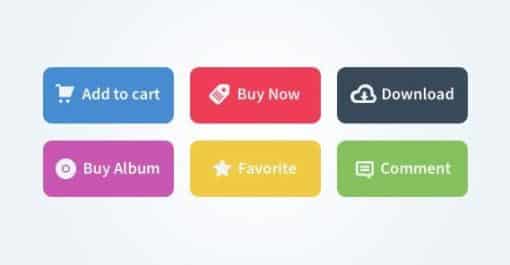
Tools like MailChimp let you cultivate a list of subscribers, so you can quickly and easily blast out new emails and posts to previous readers.
Add It All Together to Boost Blog Traffic
If you really want to boost your blog traffic, you need to write great content and get in front of your target audience with social media, advertisements and SEO. Hone in on trending topics that resonate with your readers and use catchy headlines to get them to read the entire post. You also need to reach out to other blogs and influencers for backlinks and added promotion. Anyone can create a great blog if they have the right tools at their disposal.
Most entrepreneurs and marketers struggle with blog traffic when, in fact, it has the potential to be their most lucrative customer acquisition channel.
Fortunately, at Article-Writing.co we’ve established a system for creating killer content and promoting it well.

David is the Founder and Director of article-writing.co, the fastest-growing content creation agency in North America. He has transformed companies by offering high-quality content that has impacted their SEO ranking, revitalized websites with engaging and industry-relevant blogs and website copy, and championed successful email campaign copy.




